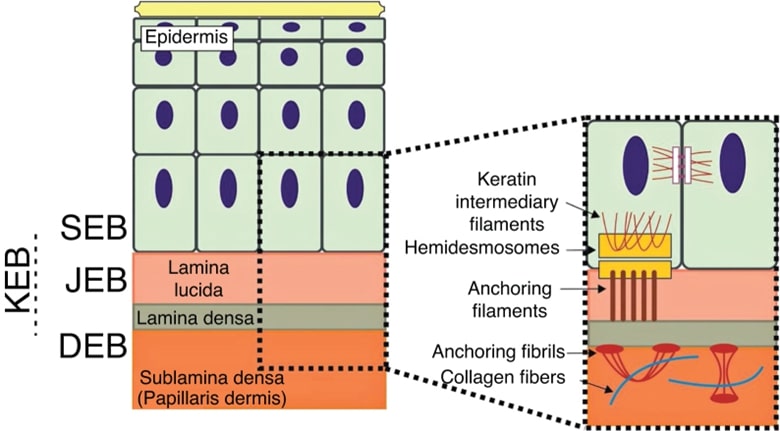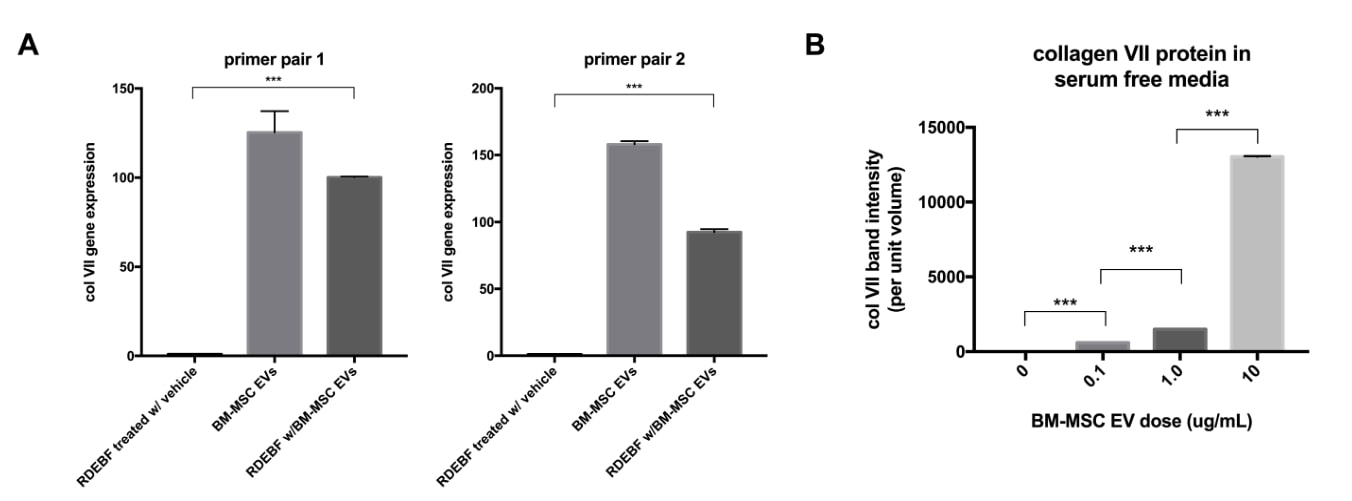Therapeutic Exosomes for Epidermolysis bullosa
Exosomes target the typical features of recurrent blistering and erosion in epidermolysis bullosa (EB), ameliorate the pathological features caused by mutations and deletions of key proteins, and prevent and alleviate wound damage and related complications. Creative Biolabs has accumulated experience in the field of exosome isolation, purification, characterization and functional analysis, and can provide EB-related exosome research services to customers from all over the world.
Genetic Factors in EB Pathology
EB is a skin disease typically characterized by skin and mucous membrane sensitivity to mechanical injury and recurrent blistering or vesicles, and may involve not only the basement membrane area of the skin, but also internal organs. genotypic subtypes. The types of hereditary EB are usually distinguished based on a combination of inheritance patterns, genotypes, and features such as clinical immunohistochemistry, electron microscopy, and the location of blisters in the ultrastructure of the skin, such as simplex (EBS), junctional (JEB), dystrophic (DEB), and Kindler syndromes (KEB).
The genetic etiology of EB is mainly due to dominant negative effect mutations in the keratin 5/14 gene, the reticulin gene, the heterodimeric transmembrane protein α6β4 integrin gene, the zebrafin-1 and the bridging granule spot protein genes, often in molecule-specific structurally sensitive regions and corresponding to their locations on keratin filaments. Severe mutations in any of the three genes encoding the three-stranded adhesion molecule (laminin-332) cause JEB pathogenesis, and the presence of mutation hotspots facilitates rapid DNA screening of patients. Mutations in the DEB genes all occur in the type VII collagen gene, including missense mutations in the glycine of the type VII collagen triple helix domain and pure or compound heterozygous mutations that produce an early stop codon on COL7A1. Kindlin-1 is a recently identified component of adherent spots in basal keratinized cells, and mutations in it lead to KEB pathogenesis.
 Fig.1 Schematic representation of the skin layers associated with the different types of EB. (Mariath, 2020)
Fig.1 Schematic representation of the skin layers associated with the different types of EB. (Mariath, 2020)
In addition to differences in expressiveness and genotype, the ultrastructure of EB subtype skin division involves different locations in the epidermis, dermis and junctional areas. Also, the larger the area of blistering of the skin on the body surface, the more severe the pathology and the higher the risk of involvement of epithelial tissues. In short, due to the complexity of EB pathogenesis and classification, research and development of its diagnostic and therapeutic strategies are valuable.
Exosomes Rely on Natural Advantages for EB Treatment
Due to the complexity of pathogenesis and pathological subtypes, the care of EB patients is still focused on blister and secondary infection prevention, while patients who are already at high risk of extracutaneous complications need timely monitoring of complications and appropriate interventions such as pharmacological, surgical, dental, nutritional and psychological approaches before severe damage to the involved organs occurs.
Several experimental new strategies are being investigated and developed. Exosomes are cell-derived extracellular membrane vesicles composed mainly of a bilayer of closed phospholipids and specific contents, which have the advantage of low immunogenicity and high biocompatibility applications; therefore, topical administration of exosomal drug material to open wounds is a promising therapeutic strategy for delaying EB blistering and erosion pathology. For example, based on the improved effect of bone marrow mesenchymal stem cells (BM-MSCs) on EB reconstructed basement membrane and skin healing, clinical studies have found that bone marrow MSC-derived extracellular vesicles (BM-MSC-EVs) promote type VII collagen deposition and blister reduction in DEB fibroblasts, which may be related to the ability of BM-MSC-EVs to donate BM-derived MSC type VII collagen and promote extracellular transport of collagen, thus inducing a rise in collagen levels in DEN fibroblasts. In addition, functional mRNAs such as Oct4 and Wnt-3 mRNAs, which are abundant in EVs, can also influence their functions upon delivery to target cells, as detected in studies where normal human skin fibroblasts showed a nearly twofold increase in type VII collagen levels after treatment with glial-forming cell-derived EVs.
 Fig.2 BM-MSC-EVs contain COL7A1 mRNA and stimulate expression of new type VII collagen protein. (McBride, 2018)
Fig.2 BM-MSC-EVs contain COL7A1 mRNA and stimulate expression of new type VII collagen protein. (McBride, 2018)
Exosomes as Drug Delivery Vehicles for EB Treatment
In addition to studying the therapeutic effects of exosomes themselves on EB, based on the important role of type VII collagen in reducing blister production and wound damage, mRNAs corresponding to key protein genes of EB subtypes such as keratin, laminin and collagen genes can be delivered to supplement skin basement membrane zone cells and keratinocytes with the delivery advantage of exosomes as carriers to protect cargo from phagocytosis and degradation in circulation.
 Fig.3 Diagrammatic representation of the skin structure and the molecular composition of exosomes. (Xiong, 2021)
Fig.3 Diagrammatic representation of the skin structure and the molecular composition of exosomes. (Xiong, 2021)
Due to the structural advantages of lipid membrane vesicles and highly biostable delivery, exosomes can be as effective as their parent cells in the care of EB-associated skin diseases. Creative Biolabs has developed a range of scientific services for extraction, purification and efficacy analysis of exosomes to assist our clients in their EB-related dermatology research. Please feel free to contact us for more information.
References
-
Mariath, L.M.; et al. Inherited epidermolysis bullosa: update on the clinical and genetic aspects. An Bras Dermatol. 2020, 95(5): 551-569.
-
McBride, J.D.; et al. Dual mechanism of type VII collagen transfer by bone marrow mesenchymal stem cell extracellular vesicles to recessive dystrophic epidermolysis bullosa fibroblasts. Biochimie. 2018, 155: 50-58.
-
Xiong, M.; et al. The novel mechanisms and applications of exosomes in dermatology and cutaneous medical aesthetics. Pharmacol Res. 2021, 166: 105490.
For Research Use Only. Cannot be used by patients.
Related Services:

 Fig.1 Schematic representation of the skin layers associated with the different types of EB. (Mariath, 2020)
Fig.1 Schematic representation of the skin layers associated with the different types of EB. (Mariath, 2020)
 Fig.2 BM-MSC-EVs contain COL7A1 mRNA and stimulate expression of new type VII collagen protein. (McBride, 2018)
Fig.2 BM-MSC-EVs contain COL7A1 mRNA and stimulate expression of new type VII collagen protein. (McBride, 2018)
 Fig.3 Diagrammatic representation of the skin structure and the molecular composition of exosomes. (Xiong, 2021)
Fig.3 Diagrammatic representation of the skin structure and the molecular composition of exosomes. (Xiong, 2021)









